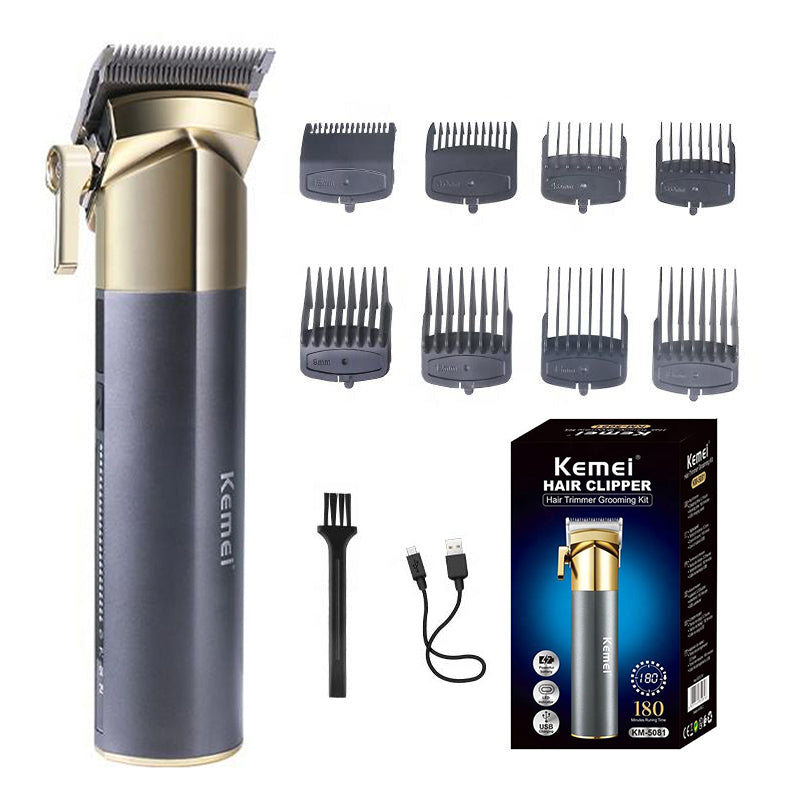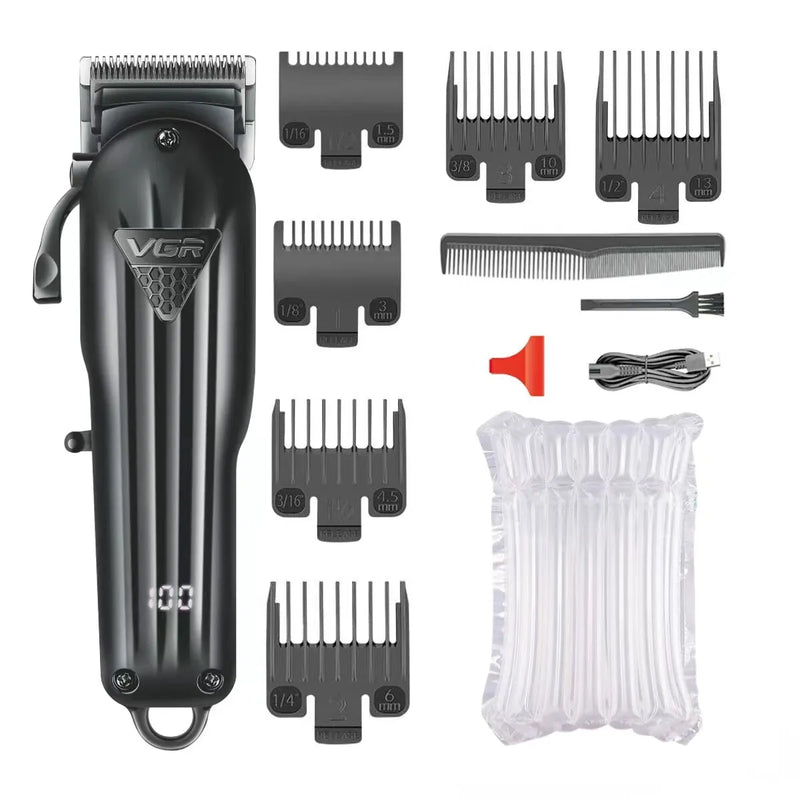Introduction
Hair clipper has become an essential tool for barbers, hairstylists, and individuals who prefer to maintain their hair at home. With a variety of options available in the market, choosing the right hair clipper can be overwhelming. In this comprehensive guide, we will cover everything you need to know about hair clippers, including types, features, maintenance, and tips for achieving the perfect haircut.
Part 1: Understanding Hair Clippers
A hair clipper is a specialized grooming tool used to cut and trim hair. It consists of a set of sharp blades that move back and forth rapidly, to cut hair to a desired length. Hair clippers are commonly used by barbers and hairstylists, but they are also popular among individuals who prefer to cut their own hair at home.
Level 1: Types of Hair Clippers
Hair clippers come in different types, ranging from professional-grade clippers to consumer-grade clippers. Professional-grade clippers are designed for heavy-duty use and are often equipped with more powerful motors. On the other hand, consumer-grade clippers are suitable for personal use and may not have as much power as professional-grade clippers.
Level 2: Corded vs. Cordless Clippers
Corded clippers are powered by electricity and need to be plugged into an outlet, while cordless clippers are powered by rechargeable batteries and provide more flexibility and freedom of movement. Each type has its pros and cons, and the choice depends on personal preference and the intended use of the clippers.
Part 2: Features to Look for in a Hair Clipper
Hair clippers come in a variety of designs, including corded and cordless models. Corded clippers are powered by electricity and require a power source in order to operate, while cordless models are powered by rechargeable batteries, allowing for greater mobility and flexibility during use. Some high-end models also feature adjustable blades, allowing for greater versatility in terms of cutting lengths.
Level 1: Motor Power
The motor power of a hair clipper determines its cutting efficiency and performance. Clippers with higher motor power are suitable for thick, coarse hair, while clippers with lower motor power may struggle with thicker hair types. It’s essential to consider the motor power based on your hair type and cutting needs.
Level 2: Blade Quality
The quality of the blades is crucial for a smooth and precise haircut. Stainless steel and ceramic blades are popular choices, with ceramic blades being known for their durability and sharpness. Some clippers also feature self-sharpening blades, which require less maintenance and provide consistent cutting performance.
Part 3: Maintaining Your Hair Clipper
Level 1: Cleaning and Lubrication
Regular cleaning and lubrication are essential for maintaining the performance and longevity of your hair clipper. After each use, remove any hair residue from the blades and apply a few drops of clipper oil to ensure smooth operation. Additionally, some clippers come with cleaning brushes and maintenance kits to simplify the process.
Level 2: Blade Replacement
Over time, the blades of a hair clipper may become dull or damaged. It’s important to replace the blades when necessary to avoid compromising the quality of your haircuts. Most clippers have detachable blades that can be easily replaced when worn out, allowing you to extend the lifespan of your clipper.
Part 4: Tips for Using Hair Clippers
There are typically two types of blades used in hair clippers: a standard cutting blade and a blending or tapering blade. The standard cutting blade is designed to cut hair to the desired length, while the blending blade is used to create a smooth transition between different hair lengths, such as when creating a fade haircut. Hair clippers are an essential tool for creating a variety of hairstyles, from simple buzz cuts to intricate patterns and designs. They are also widely used for maintaining short and medium-length hair, as well as for trimming facial hair, such as beards and mustaches.
Level 1: Choosing the Right Guard Combs
Guard combs are used to adjust the cutting length of the hair, and they come in various sizes. When using hair clippers, it’s essential to select the appropriate guard comb based on the desired hair length. Understanding the guard comb sizes and their corresponding cutting lengths will help you achieve the haircut you desire.
Level 2: Technique and Precision
Using hair clippers requires practice and precision to achieve an even and well-blended haircut. Understanding proper clipping techniques, such as using guide strokes and maintaining consistent pressure, will help you achieve professional-looking results. It’s also important to pay attention to detail and take your time to ensure a polished outcome.
Part 5: Finding the Right Hair Clipper for You
Level 1: Consider Your Hair Type and Needs
When choosing a hair clipper, consider your hair type, the frequency of use, and the specific features you require. For example, if you have thick hair, a clipper with a powerful motor and high-quality blades would be ideal. If you prefer portability and convenience, a cordless clipper with a long battery life may be a better option.
Level 2: Reading Reviews and Comparing Options
Before making a purchase, it’s beneficial to research and read reviews of different hair clippers. Look for feedback on performance, durability, and overall satisfaction from other users. Additionally, comparing the features and specifications of various clippers will help you make an informed decision based on your preferences and budget.
Part 6: How to Choose the Right Hair Clipper for Your Needs
When choosing a hair clipper, it’s important to consider your specific needs and preferences. Here are a few factors to keep in mind:
- Cutting Length: Different clippers come with different cutting lengths, so consider the length of hair you want to achieve before making a purchase.
- Corded vs. Cordless: Corded clippers are typically more powerful and reliable, but cordless clippers offer more flexibility and convenience.
- Blade Material: Look for clippers with high-quality, stainless steel blades for long-lasting durability and sharpness.
- Motor Speed: A more powerful motor will help you achieve a smoother and more consistent cut.
- Additional Features: Some clippers come with extras like adjustable blades, multiple guard sizes, and even attachments for detailing and grooming.
By considering these factors, you can make an informed decision and choose the right hair clipper for your needs.
Part 7: Maintaining and Cleaning Your Hair Clipper for Longevity
Proper maintenance and cleaning of your hair clipper is essential for its longevity and performance. Here are some tips to keep your clipper in top condition:
- Regular Oil Application: Apply a few drops of clipper oil to the blades before and after each use to keep them lubricated and running smoothly.
- Cleaning the Blades: Use a small brush to remove hair clippings and debris from the blades after each use. You can also use a blade wash to ensure a thorough clean.
- Blade Replacement: Over time, blades can become dull or damaged. It’s important to replace them when necessary to maintain the best cutting performance.
- Store Properly: Store your hair clipper in a clean, dry place to prevent dust and moisture build-up.
By following these maintenance tips, your hair clipper will continue to perform at its best and last for years to come.
Part 8: Tips for Using a Hair Clipper at Home
Using a hair clipper at home can be a convenient and cost-effective way to maintain your hairstyle. Here are some tips for achieving the best results:
- Start with the Right Guard Size: Choose the appropriate guard size to achieve the desired hair length. Start with a longer guard size and gradually work your way down if needed.
- Go Against the Grain: To achieve an even cut, move the clipper against the direction of hair growth.
- Use a Comb: For more precise cutting and blending, use a comb to lift the hair and guide the clipper.
- Take Your Time: Slow and steady wins the race. Take your time to ensure an even and well-blended cut.
- Clean Up: After you’re finished, use a brush to remove any loose hair and debris from the clipper.
With these tips in mind, you can confidently use your hair clipper at home and achieve salon-quality results.
Conclusion
When using hair clippers, it is important to follow proper maintenance and care procedures to ensure their longevity and performance. This includes regular cleaning and oiling of the blades, as well as ensuring that the motor and other components are kept free from debris and hair clippings. Additionally, ensuring that the blades are kept sharp is essential for achieving clean and precise cuts.
Overall, hair clippers are a versatile and essential tool for anyone looking to maintain their hairstyle or perform their own grooming at home. With proper care and maintenance, a quality pair of hair clippers can provide years of reliable performance and help achieve a variety of stylish looks.
Hair clippers are versatile tools that offer a convenient way to maintain your hair and achieve a professional-looking haircut. By understanding the different types of clippers, key features to look for, maintenance tips, and techniques for using clippers, you can make the most out of this essential grooming tool. Whether you’re a hairstylist or an individual looking to groom your hair at home, finding the right hair clipper will make a significant difference in your grooming routine.






